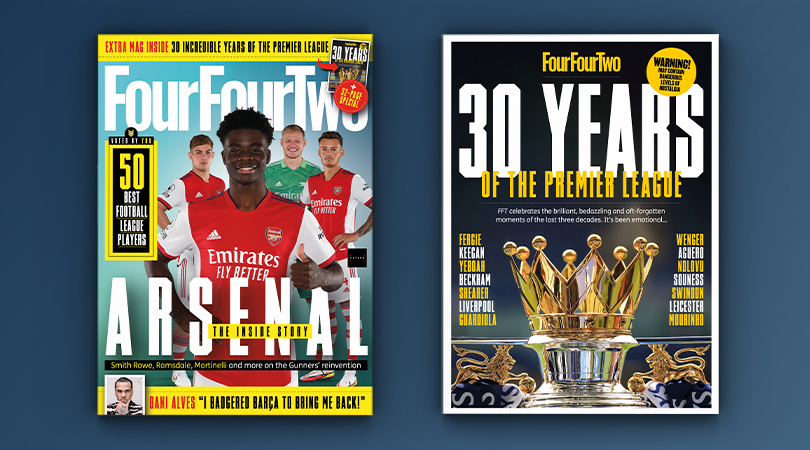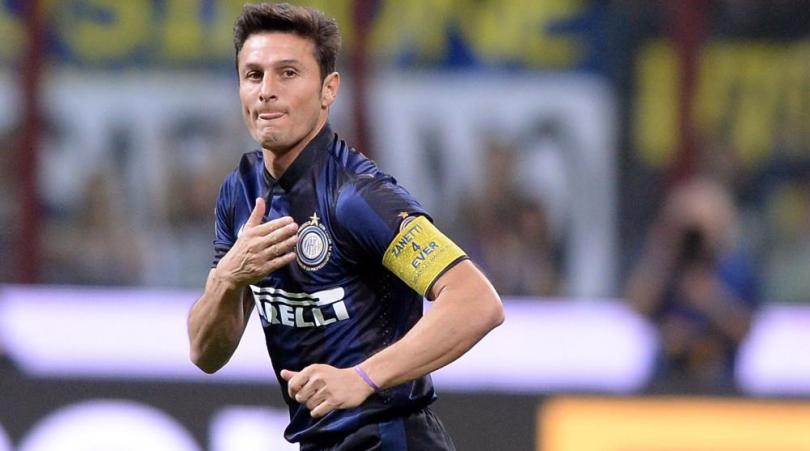The future of Arsenal: The complete story of Emile Smith Rowe and Bukayo Saka's rise to the top
Arsenal young guns Emile Smith Rowe and Bukayo Saka grew up an hour from each other, idolising Gunners heroes: now they're leading the club into a brave new dawn

It was an odd place to hear it but in November 2021, San Marino was alive with the sound of Status Quo. The rock group’s arena-filler Rocking All Over The World has been adopted by Arsenal fans – but that night, it was England fans signing, “I like it, I like it, I like it, ohhhh, here we go...” before replacing the song’s title with the two stars of the show: Bukayo Saka and Emile Smith Rowe.
It’s rung around the Emirates Stadium ever since fans have been back in their seats post-lockdown. The Arsenal faithful have no problem in squeezing two stars into the same chorus and are well used to classic double acts, after all: Adams and Bould, Vieira and Petit, Henry and Bergkamp... Wenger and his coat.
The electric new duo of Saka and Smith Rowe has all the ingredients of what made some of those historic couples great, too.
The fire of Smith Rowe, a quickness and instinct whenever he has the ball to drag his team across the pitch, contrasts beautifully with the icy calmness of Saka, a player who can seemingly stop time when the ball reaches his feet and take a moment to survey his surroundings. While Smith Rowe will bust a gut to make the late run into the box, it’s usually Saka making the pinpoint pass to his mate. One has his socks low, the other high; one’s right-footed, one’s left: it’s as if Mikel Arteta slaved over a petri dish to create two attackers in his team’s image.
Yet they’re bound by similar roots, having both progressed through the famed Hale End academy that brought the likes of Cesc Fabregas and Jack Wilshere to the masses. Saka and Smith Rowe both have a shyness to them. A wide smile when discussing the beautiful game and each has a loveable cockney twang to their accents. And the lightning-quick feet that they both have, and both showcase in tandem on the pitch together, is perhaps only a fraction of the reason that they’ve endeared themselves to Gooners’ hearts quite so quickly.
Early starters at Arsenal
Saka and Smith Rowe grew up about an hour away from one another; the former in Ealing, West London, the latter in Croydon, down south. Both have similar backgrounds.
Bukayo Saka’s parents moved to London from Nigeria and his family sacrificed plenty for their son’s gift. Saka has since credited his parents with so much – especially his father, who he says instilled the discipline and politeness that made him a favourite with teachers and youth coaches. Saka Snr would collect Bukayo from school and make the hour-and-a-half trip from West London to North, just so his son could play for the Gunners’ Hale End academy. Bukayo would sleep in the car on the way home – and he’s said since that every time he pulls on a red and white shirt, he remembers what his father gave for him to do that.
Get FourFourTwo Newsletter
The best features, fun and footballing quizzes, straight to your inbox every week.
“When you do stuff like I’ve done then it’s easy to get big-headed,” Saka said when talking about his incredible rise. “But when I have people like my dad around with me, he just keeps me grounded and that’s perfect for a player like me.”
Emile Smith Rowe knows what that is like. The youngster was extremely close with his family growing up, too – and was living with his mum as late as when he was given the no.10 shirt at Arsenal in 2021. While Saka was a whizz at school, achieving three A* grades and four As at GSCE, Smith Rowe has since claimed that he could never focus in school and has no idea what he’d be doing for a living if it wasn’t for football. Luckily, the sport is in his blood.
A post shared by Ian Wright (@wrightyofficial)
A photo posted by on
Smith Rowe’s father, Les, played football semi-professionally and went to school with a certain Ian Wright, who beamed with joy on Match of the Day when Smith Rowe Jr was given his break in the Premier League. Growing up around an Arsenal legend is one way to become a fan.
“I’ve known about his talent, known about how his dad had to drive him from South London,” Wrighty grinned. “Just to see him out there, it makes me really pleased.”
Both grew up adoring Arsenal. Bukayo Saka cites Thierry Henry as his all-time favourite player and used to wear the same boots as Alexis Sanchez when he was modelling his game on the Chilean. Smith Rowe, meanwhile, turned down an offer from Tottenham as a child, saying, “I stood by Arsenal. They’re my club.”
Arsenal fans are used to the conveyor belt. It’s a circle of life at London Colney.
“If you ask Bukayo and Emile they will tell you how they were inspired by Jack Wilshere, Fabregas, Bellerin,” Per Mertesacker told the Daily Mirror. “The next generation of Under-9 players at the academy will be inspired by these players.”
Developing well
Saka first made his debut in 2018 as a wiry left-winger off the bench in the Europa League for the Gunners. This highly promising teen, the no.87 on his back, appeared sporadically under Unai Emery as part of his education and in January 2019, he became the first player born in the 21st century to play in the Premier League for Arsenal. 13 goals and assists in 20 games for the under-23s under Freddie Ljungberg certainly helped convince those at the club that he was on the right track.
“We’ve given him 15 minutes here and 20 minutes there to help him get used to the tempo, the speed and strength of opponents, and he’s taken it in his stride,” Ljungberg said after Saka scored a devastating counterattacking goal against Liverpool’s under-23s. “He’s just going to get better and better, keep his head down and keep on working.”
Emile Smith Rowe was emerging at the same time, and among many fans, actually generating more hype. Saka was cool and considered on the ball but his main strength was always his maturity and decision making; Smith Rowe, meanwhile, was more obviously exciting. A member of the U17 World Cup-winning England squad in 2018 alongside the likes of Phil Foden, Jadon Sancho and Conor Gallagher, he shot to prominence in clips on YouTube, slaloming through defenders in games for the Hale End youth teams. In one such match against Blackpool at the Emirates Stadium, the youngster picked the ball up in his own half and ghosted past four opponents, racing into the penalty area as he slipped into fifth gear. It looked effortless for him – and yet no one could get near him.
A post shared by God’s Child 😇 (@bukayosaka87)
A photo posted by on
Saka went under the radar a little as Smith Rowe dazzled on preseason tours, with Unai Emery saying he “looked forward to working with” the latter before Smith Rowe headed to RB Leipzig on loan. Leipzig wanted to take him permanently: Arsenal flat-out refused. Saka was never touted for a loan, however, with the club feeling like the youngster’s development was better served under the likes of Ljungberg and Mertesacker. As a slight player who could seemingly turn his hand to any position, the expectation was that he might blossom in any one of four or five positions – and that in an injury crisis, his maturity might just earn him an early break.
The pair’s development was coming during a period of uncertainty. Arsenal’s route from Hale End to Arsene Wenger’s squads were always clear – but things were a little hazier, now. Emery’s side fluctuated in form, with big stars underperforming, rumours of dressing room fall-outs and on-field progress looking marginal. In the summer of 2019, youth coach Ljungberg was added to the first-team staff to help ease a few of the impressive youngsters’ paths into the limelight.
It turned out to be a masterstroke. Emery didn’t last much longer in the Emirates hot seat but provided opportunities for Saka in the 2019/20 season, first in the Europa League, before making the big call to drop him in the heat of the Premier League. Arteta merely picked up where his predecessor left off, utilising the young Saka at left-back, to give him an education in marking, positioning and bombing down the wing. Smith Rowe toiled at Huddersfield on loan while Saka played multiple positions under a new manager. The youth at Arsenal soon became the core of what Arteta knew he could trust.
“They have to earn that right to play and they are doing that,” the Spaniard said of his talented youngsters. “That’s a really positive thing and how lucky we are to have this generation.”
The big opportunity
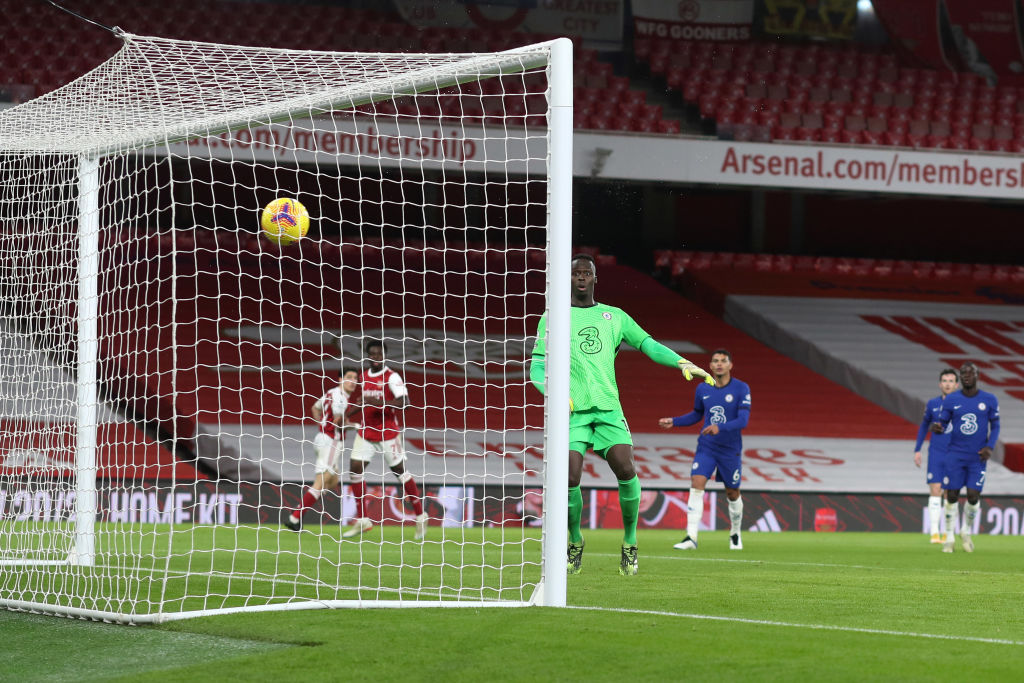
Christmas Day 2020 must have been a tense one in the Arteta household. He knew he could be unemployed by New Year: Arsenal had gone seven games without a win and were set to host Chelsea’s big-money superstars the next day. Summer signing Willian had been an unmitigated disaster. Record signing Nicolas Pepe was shot of confidence. Even captain Pierre-Emerick Aubameyang was struggling.
From the fire of a crisis, two young guns were forged in the flames. Saka was a regular feature by now but this was his rebirth as a right-winger, with Smith Rowe on his Premier League debut in the centre, drifting between him and Gabriel Martinelli on the left. The trio had an average age of 19 but weren’t afraid to run at the Blues defence, cut inside and ask questions of their opponents. The energy levels of the entire team lifted: it was like someone had plugged the Gunners back into the mains.
Just before the hour-mark, Smith Rowe slid the ball to Saka, who looped a cross-cum- shot over the head of Edouard Mendy for the young guns’ third goal. From that point onwards, Arteta’s Arsenal were never to be the same again: their emergence, in part, helped alter the direction of the entire club.
“We had to redefine our culture, redefine our strategy and we had to get younger on the pitch,” director Josh Kroenke told Sky Sports in autumn 2021. “From Hale End to some of the players we’ve brought in, you’re starting to see some of those players come through, you’re starting to see their qualities shine. The senior players are really embracing the younger players.”
The pair went from strength to strength. A 4-0 victory over West Bromwich Albion showcased exactly what Smith Rowe was in the side for, as the new addition knitted together the most beautiful of moves before Saka finished off a stunning team goal in the snow. It was Smith Rowe who got the decisive winner in the FA Cup at the Emirates Stadium against Newcastle United, stepping up when the senior players were all out of gas, while Saka ran the show away at Southampton, in a 3-1 win. The pair would almost take turns for a go in the spotlight, with mixed form from the team as a whole not lifting the Gunners much higher in the table.
Bukayo Saka’s emergence as an England regular culminated in his inclusion in the Three Lions’ Euro 2020 squad, where he featured regularly, up until his decisive heartbreaking penalty miss in the final. Smith Rowe, meanwhile, tore under-21 defences apart during international breaks.
Perhaps most tellingly, Arsenal started the 2021/22 season with Saka as no.7, Smith Rowe no.10: the two most prized shirts in football going to two players still not yet 21. The entire transfer window revolved around bringing in more youth to supplement the squad – especially these two talents and Martinelli – as Saka himself was consulted on whether Arteta should bring in England teammate Ben White.
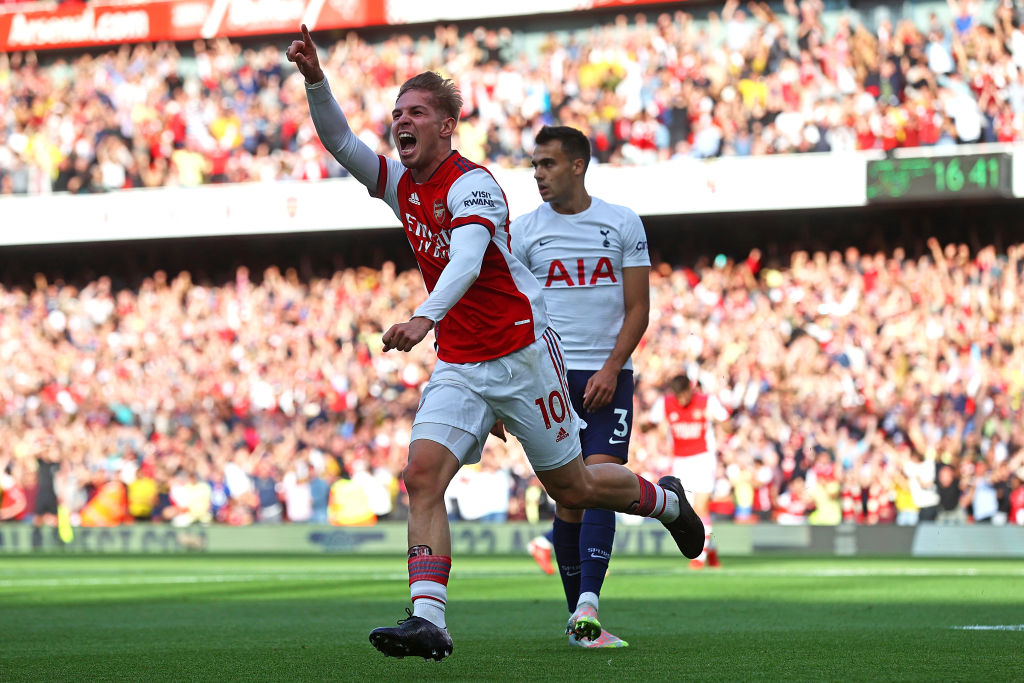
2021/22 continued where the previous season had left off for the dynamic duo (after the slight hitch of three opening defeats). With fire in their heels, the young guns raced out of the blocks for a North London Derby in September, countering through Tottenham like a hot knife. Smith Rowe opened the scoring and assisted captain Pierre-Emerick Aubameyang before Bukayo Saka added a third all before half- time. The legendary Thierry Henry was spotted up in his box, watching his successors tear apart Arsenal’s biggest rivals: it was perhaps the noisiest that the Emirates Stadium had been since Henry himself returned to the club in 2012.
It wasn’t just about the excitement of the game, either – the frenetic energy of the Arsenal side and the fact that Spurs were being slaughtered in front of the Gunners faithful. It was the fact that such a young team were coming together as one. “Made in Hale End,” Jack Wilshere tweeted following the game, perhaps recognising the torch that he’d passed on to two of the goalscorers that day.
At the end of 2021, the progress of Arsenal’s starlets was clear for all to see. A year on from that fateful Boxing Day at the Emirates, Arsenal travelled to Norwich City, buoyed by recent confidence. It took six minutes for Saka to find the back of the net, squeezing a shot through the tightest of angles after his trademark pause on the ball; the 20-year-old was at the centre of everything, getting a second in the second half before Smith Rowe cameoed late on to add a fifth. This was no longer fringe youngsters taking their hard-earned opportunities: this was a display of quality and confidence from the first-teamers running riot.
One wonders how Saka, Smith Rowe, Martinelli and the plethora of youngsters coming through at Arsenal go from here. Leading a club as big as this and growing up together, developing further, these youngsters aren’t just the future, they’re the present, too. The understanding between them has grown: what will they be capable of in a year, two years, five years or even ten, should they all stay together?
“I’d like to give back to the club after everything they’ve done for me so far and, as a result, become a Gunners legend,” Martinelli told FFT exclusively in 2020, while Smith Rowe told the Evening Standard, “I’d love to be here forever” and Saka told Arsenal.com, “I want to stay humble and just keep getting better... why here? It’s Arsenal, you know! Come on, it’s Arsenal.”
There was a picture at Hale End of Jack Wilshere on the wall for all the youngsters to see, every day, when Saka and Smith Rowe were a part of the famed academy. In years to come, it could well be the two men up there whose names ring around the Emirates – and San Marino.
For a limited time, you can get five copies of FourFourTwo for just £5! The offer ends on May 2, 2022.
Restock your kit bag with the best deals for footballers on Amazon right now
QUIZ! Can you name every country to compete at a FIFA World Cup?
RANKED! The 25 greatest Premier League shirts ever
YOU ASK THE QUESTIONS Kolo Toure: “Slide-tackling Arsene Wenger changed my Arsenal career – it showed him just how much I wanted it!”
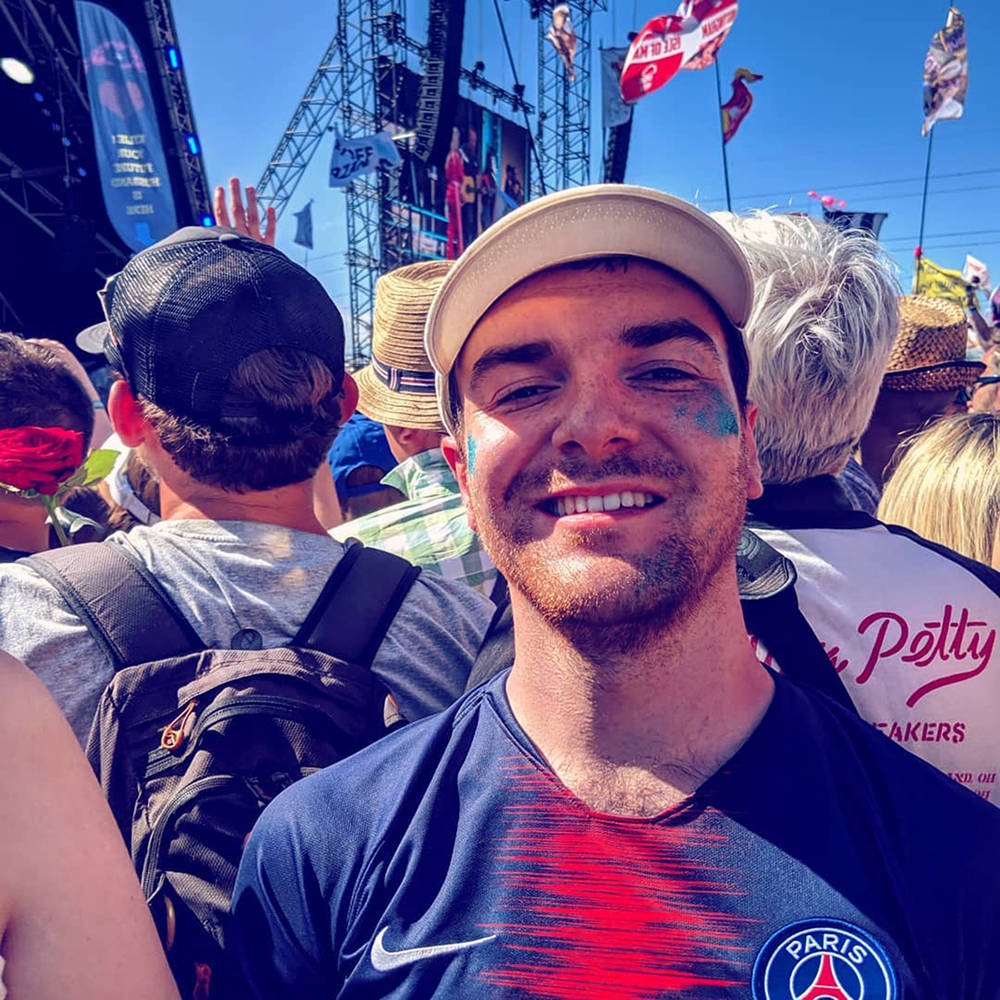
Mark White has been at on FourFourTwo since joining in January 2020, first as a staff writer before becoming content editor in 2023. An encyclopedia of football shirts and boots knowledge – both past and present – Mark has also represented FFT at both FA Cup and League Cup finals (though didn't receive a winners' medal on either occasion) and has written pieces for the mag ranging on subjects from Bobby Robson's season at Barcelona to Robinho's career. He has written cover features for the mag on Mikel Arteta and Martin Odegaard, and is assisted by his cat, Rosie, who has interned for the brand since lockdown.
